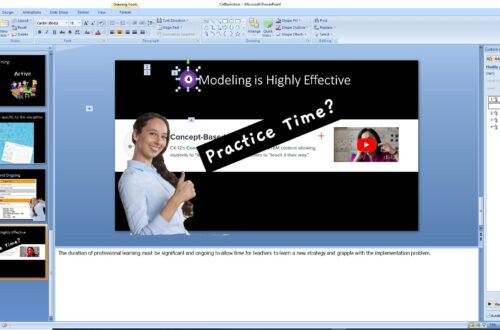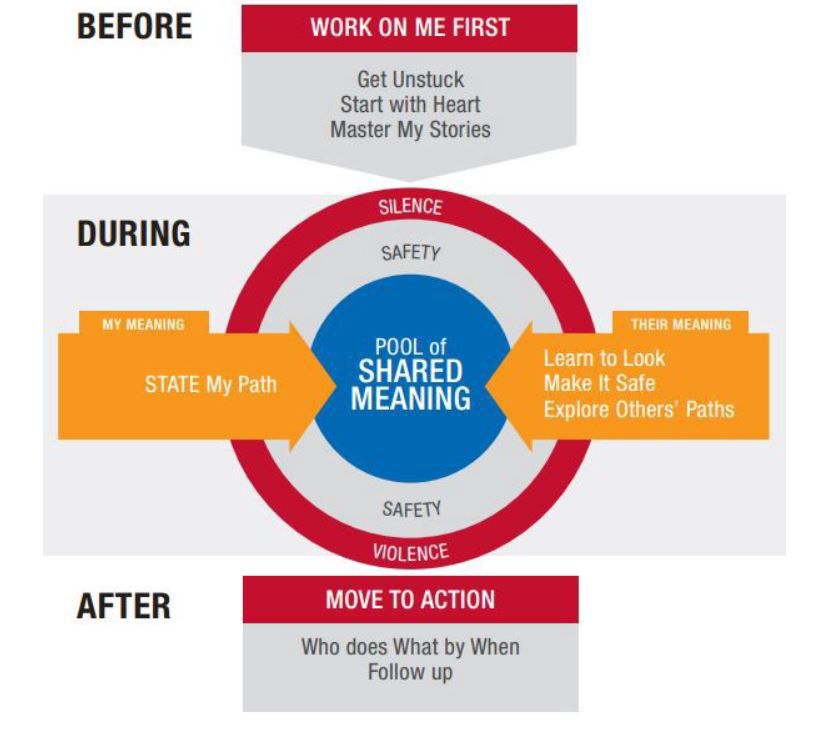
Crucial Conversations
Mastering the skills of effective communication is the absolute foundation of success in life. To be an effective communicator, a leader should aspire to become a self-differentiated leader. Friedman indicates that differentiation of self is the ability to step out of the system to distinguish between thoughts and feelings. One does not become devoid of emotions so how can you separate emotion from needs. The skills learned in the book “Crucial Conversations” will help the leader make those separations taking a big step in the direction of autonomy. Ultimately, society wants leaders that can detach from the issue leaving their personal feelings behind and make logical and rational decisions for the good of the people they manage.
In reality, we are constantly dragged away from goals and placed into a situation of unresolved issues between two people. The goal of a self-differentiated leader is to make individuals responsible for themselves, and being roped into emotional triangles creates a kink in creating autonomy among subordinates. Worse yet, being placed into the situation of a mediator may inject excess stability in the situation and hamper that individual’s ability to self-govern. The majority of issues leaders face are in the form of emotional triangles, which can be either positive or negative. The issue does not have to be between just individuals but can also be choices. Since a person not connected has no influence on the system, the problem is not being forced into the emotional triangle, but rather the leader reacts and guides the problem appropriately. Of course Friedman gives guidance on how to spot the situation, but was light on teaching us to make the person responsible for their problem. The book “Crucial Conversations” truly gave me a method to act as a leader and guide, while still remaining connected to become the self-differentiated leader that makes progress in my organization.
What are Crucial Conversations?
These conversations take us by surprise. We are just going about our day when someone says something and before you know it we lose all attempts at polite conversation. These events happen when a conversation is about emotional topics, high-stake outcomes, or differing opinions of deeply held beliefs. We all should be familiar with these types of incidents. When the conversation ends, rude behavior cannot be withdrawn and relationships move apart or break. So many people just steer clear of these conversations to avoid the possible loss of a spouse, added stress to a work environment, or disruption of peace with a neighbor. Of course, this state of being is just a false peace as we boil on the inside about the problems that are occurring. These feelings may show in a manner that is subtle and unbecoming such as a sarcastic remark, shifts in body language, or even harsher tones, but regardless the feelings seep through the cracks of our fake smiles and false peace. When it comes to these high stakes conversations I have always felt that I was between a rock and a hard place, a no-win scenario. However, I now know that I have the ability to wiggle right out of that no-win scenario if I learn to master crucial conversation strategies. The inability to communicate appropriately has major impacts on our daily lives, not just in work, but all aspects can be affected, including health and family.
How to Master Crucial Conversations
To get unstuck, I must identify the crucial conversation and implement the 8 tips to successful crucial conversations. Safely navigating these encounters would be beneficial for all that are involved. In the book “Crucial Conversations,“ I learned how to communicate without resorting to silence or violence. Mastering the skills of effective communication is the absolute foundation of success in life. These crucial conversation skills will allow me to recognize when emotions are high and conversations are moving away from safety. Implementing these skills will mold me into a self-differentiated person by creating awareness of the emotions and flow in a conversation. Becoming self-aware of my emotions while gaining control allows the free flow of meaning in a conversation without losing focus on the details. To manage crucial conversation, I will be required to know myself. I will need to be self-aware of my motives and ensure that I am not moving away from meaningful dialogue.
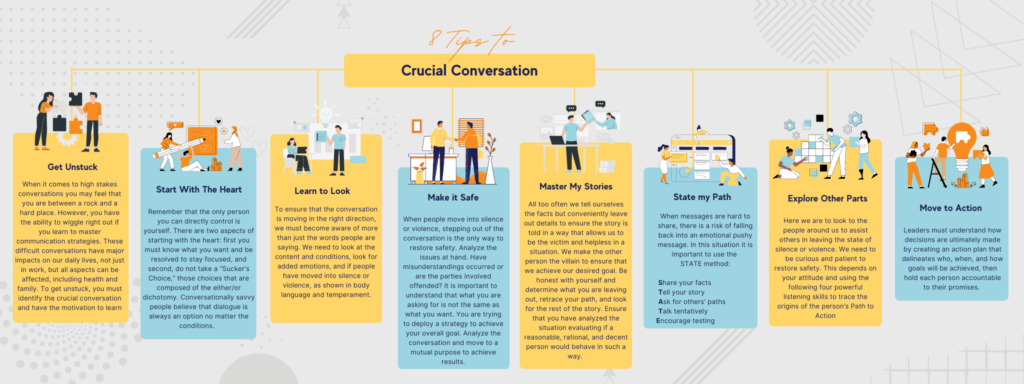
Get Unstuck:
When it comes to high stakes conversations you may feel that you are between a rock and a hard place. However, you have the ability to wiggle right out if you learn to master communication strategies. These difficult conversations have major impacts on our daily lives not just in work but all aspects can be affected including health. To get unstuck, you must identify the crucial conversation and have the motivation to learn.
Start with Heart:
According to the authors, “Skilled people Start with Heart. That is, they begin high-risk discussions with the right motives, and they stay focused no matter what happens.” There are two aspects of starting with the heart, first you must know what you want and be resolved to stay focused. Second, do not take a “Suckers Choice,” these choices are composed of the either/or choices. Conversational savvy people believe that dialogue is always an option no matter the conditions.
Learn to Look:
To ensure that the conversation is moving in the right direction, we must become aware of more than just the words people are saying. We need to look at the content and conditions, look for added emotions, if people have moved into silence or violence.
Make it Safe:
When people move into silence or violence, stepping out of the conversation is the only way to restore safety. Analyze the issues at hand. Have misunderstandings occurred or are the parties involved offended? It is important to understand that what you are asking for is not the same as what you want. You are trying to deploy a strategy to achieve your overall goal. Analyze the conversation and move to a mutual purpose to achieve results.
Master My Stories:
All too often we tell ourselves the facts but conveniently leave out details to ensure the story is told in a way that allows us to be the victim or helpless in a situation. We make the other person the villain to ensure that we achieve our desired goal. Be honest with yourself and determine what you are leaving out, retrace your path, and look for the rest of the story. Ensure that you have analyzed the situation evaluating if a reasonable, rational, and decent person would behave in such a way.
State My Path:
When messages are hard to share, there is a risk of falling back into an emotional pushy message. In this situation it is important to use the STATE method.
- Share your facts. Start with the least controversial, most persuasive elements
- Tell your story. Explain what you’re beginning to conclude.
- Ask for others’ paths. Encourage others to share both their facts and their stories.
- Talk tentatively. State your story as a story-don’t disguise it as a fact.
- Encourage testing. Make it safe for others to express differing or even opposing views.
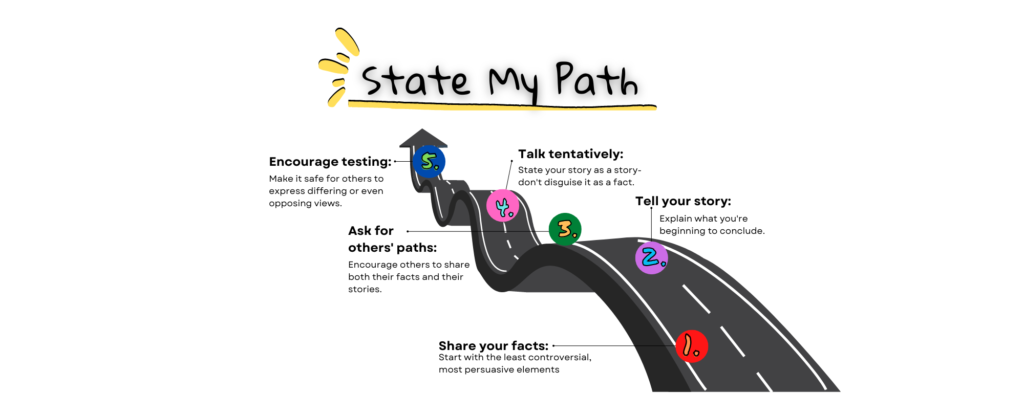
Paths to Action:
Here we are to look at the people around us to assist people in leaving the state of silence or violence. We need to be curious and patient to restore safety. This depends on your attitude and using the following four powerful listening skills to trace the origins of the person’s Path to Action.
- Ask: Express interest in the other person’s views
- Mirror: Create a mirror for the other person by walking through the parts of their Path to Action and describe how they look or act.
- Paraphrase: Put the message in your own words
- Prime: When others want to share but still don’t feel safe
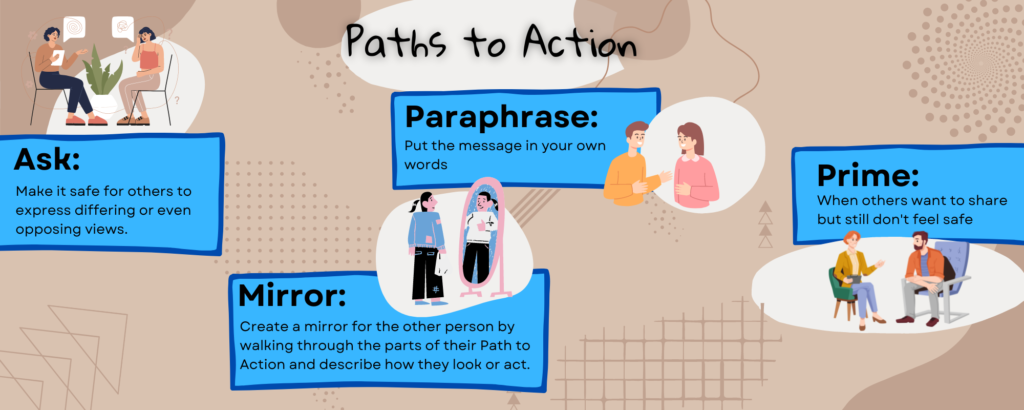
Move to Action:
Leaders must understand how decisions are ultimately made by creating an action plan that delineates who, when, and how goals will be achieved, then hold each person accountable to their promises.
Implementation of Crucial Conversations
Learning these navigation skills will be a work-in-progress for some time. I have set my goal and plan to master these conversation skills before the end of next year. Once mastered, I will be able to redirect the conversation which allows for more effective communication, creating a safer work environment. As a team leader, I cannot afford to merely go along with the crowd, rather I must ensure that the crowd is moving toward the organization’s goals. These are tough conversations, but when handled tactfully make tremendous progress in the workplace toward organizational goals. Some concepts may be unpopular or difficult to talk about, for instance a hygiene problem or insubordination. I foresee needing excellent communication skills when getting people on board to implement the innovation plan for student paced learning using station rotation. Change is hard, especially in this program, as educators will be required to stop teaching “at” the students and become a guide. Educators resistant to such a plan will see this as “not really teaching” and will actively attempt to “fix” the plan by reintroducing ineffective teaching strategies. Further, educators will have real concerns regarding effective implementation and comfort with the plan, as well as needing the conversation skills to help the students get on board. I hope to teach the skills and model how to communicate effectively as my team learns how to implement the innovation plan.
Resources:
Grenny, J. (2012). Crucial conversations. McGraw Hill.
Image 1: Boston College. Crucial Conversations Model. Retrieved December 3, 2022, from https://www.bc.edu/content/bc-web/offices/human-resources/sites/employee-development/programs/crucial-conversations.html.





